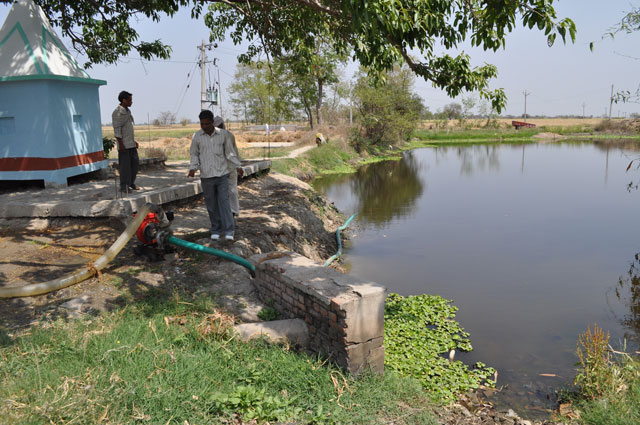Sustainable groundwater management underpins food security in South Asia
The most intensively cultivated areas of South Asia are crucial for regional food security and have become global hotspots of groundwater exploitation.
01/06/2021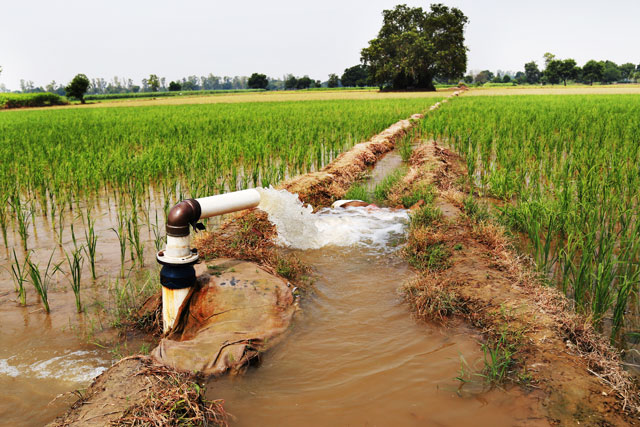
Agriculture is crucial for the livelihoods of many in South Asia, with more than one billion people engaged in food production. The importance of agriculture to many Indian people was starkly illustrated by the recent protests opposing changes to India’s farming laws.
The Green Revolution
Agricultural practice in South Asia, as in many other parts of the world, was transformed in the 1950s and 1960s during the ‘Green Revolution’. The transformation was driven by four fundamental developments:
- the advent of new high yielding varieties of cereals, especially rice and wheat
- the adoption of chemical fertilisers
- increased mechanisation
- increased access to irrigation
The fourth development, increased access to irrigation, is arguably the most important and was driven by large-scale exploitation of groundwater and policies providing free electricity for groundwater pumping.
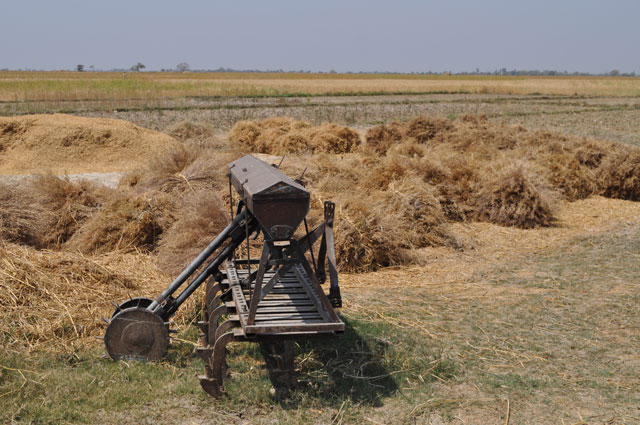
After the harvest — Northern India. Image courtesy of D J MacAllister © BGS.
Prior to the Green Revolution, water for irrigation in South Asia was primarily drawn from the region’s great rivers and distributed via a large network of canals. However, in India in the early 1970s, the area irrigated by groundwater surpassed that irrigated by surface water for the first time. The number of irrigation tube-wells and, as a consequence, agricultural reliance on groundwater has increased ever since (Mukherji, 2020).
The world’s most exploited aquifer
North-west India and central Pakistan are the most intensively cultivated areas in South Asia and are crucial for regional food security. Both areas have a long history of major surface and, more recently, groundwater development. Combined, the areas are regional breadbaskets, representing the largest contiguous tract of irrigated land (Basharat et al., 2013) and the most intensively irrigated (Siebert et al., 2010) in the world. As a consequence, north-west India and central Pakistan have become global hotspots of groundwater exploitation (Ahmed et al., 2019; Trepathi et al., 2016; Watto et al., 2018) and the long-term viability of the transboundary aquifer that underpins the region’s agriculture is threatened.
The problem is so severe it can be observed from space. The Gravity Recovery and Climate Experiment (GRACE) satellites, launched in 2002 by NASA and the German Aerospace Centre, showed that groundwater depletion was leading to changes in the Earth’s gravity field (Rodell et al., 2009; Tiwari et al., 2009; Chen et al., 2014; Bhanja and Mukherjee, 2019; Tang et al., 2017; Ahmed et al., 2019).
BGS work in South Asia
Since 2012, BGS has worked with partners in South Asia, including the National Institute of Hydrology in India and the International Waterlogging and Salinity Research Institute in Pakistan, to examine in more detail the sustainability of groundwater abstraction in the region. Our work was the first to develop a 3D picture of the regional aquifers (Bonsor et al., 2017) and to map transboundary groundwater depletion and water quality using in situ data (Macdonald et al., 2016).
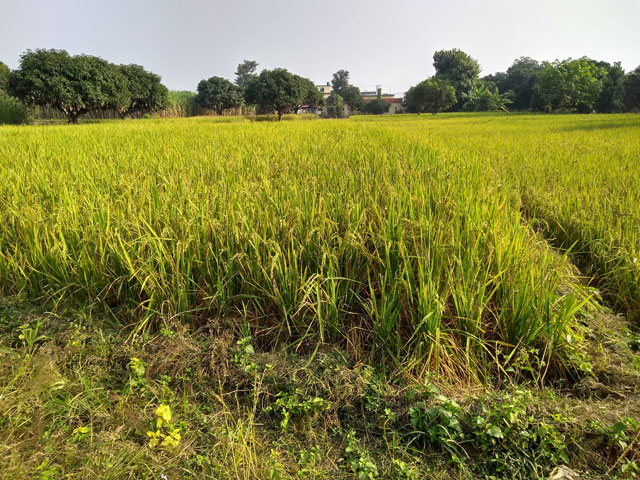
Wheat field — Northern India. Image courtesy of D J MacAllister © BGS.
The large floodplains of the rivers Ganges, Indus and Brahmaputra form a huge aquifer made up of sands and gravels, which are washed down from the Himalayas by the rivers and their tributaries. The sediments are deposited as the rivers slow down when they enter the plains, forming a vast regional aquifer many hundreds of metres thick. The properties of the aquifer change along the course of the rivers and with depth, leading to a complex variation in water availability and water quality.
BGS work has shown that groundwater depletion is nuanced, regionally heterogenous and influenced by a combination of human and climatic factors. For example, BGS recently illustrated the importance of recharge from the vast canal network (MacDonald et al., 2016) as playing an important role in controlling groundwater levels in the region, while other studies highlight the impact of changes in monsoon precipitation (Asoka et al., 2017).
Climate change
While the human influence on groundwater in the highly cultivated areas of north-west India and central Pakistan is clear, the climatic influence is harder to unravel. However, there is evidence that climate change will impact the region’s groundwater resources and, by extension, agriculture and food security. For example, changes in the intensity of rainfall may led to less groundwater recharge (Asoka et al., 2018) and increased melting of glaciers in the Himalayas could lead (particularly in the Indus) to short-term increases in groundwater recharge via rivers and canals, but ultimately a long-term decline (Immerzeel et al., 2010). Other studies suggest that groundwater pumping itself is influencing the monsoon cycle and changing the timing and location of monsoon rain (Devanand et al., 2019).
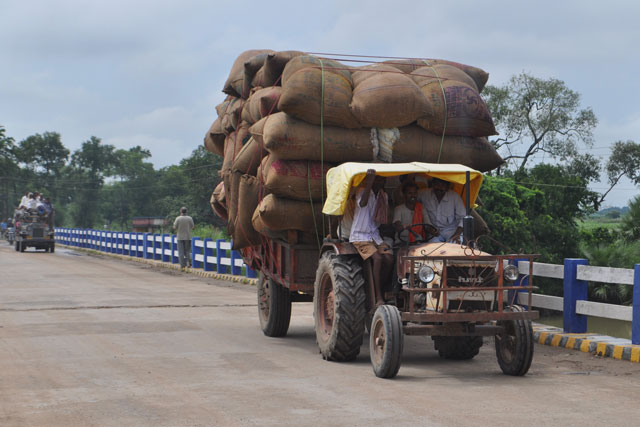
Farmers transport their goods to market — Northern India. Image courtesy of D J MacAllister © BGS.
While there is still a need to better understand the climatic mechanisms that control groundwater recharge in the region, it appears clear that climate change has an indirect effect on groundwater levels. Increasingly unreliable rainfall influences changes in farmer behaviour, which in turn affect groundwater development. Since short- to medium-term climate change is forecast to lead to increased availability of surface water, mainly as a result of melting glaciers in the Himalayas, conjunctive use of both surface and groundwater resources may help increase food security while managing groundwater decline.
Managing groundwater
At present, one of the most significant challenges to halting the decline of groundwater levels in the region is ongoing electricity subsidies for irrigation (Mukherji, 2020). For many years, farmers have been able to pump groundwater for little or no cost. These subsidies have become a political hot potato and creative thinking is needed to address the impact they have on groundwater levels in the region. For example, there is evidence that relatively modest decreases in groundwater abstraction of around 20 per cent have the potential to decrease rates of groundwater depletion in India by between 36 and 67 per cent (Shekhar et al., 2020). The largest impacts are likely to be in the most heavily exploited areas. Evidence for the impacts of modest decreases in abstraction has also been demonstrated in the High Plains Aquifer of the USA (Butler et al., 2020). In some areas of north-west India, groundwater levels have risen in the last decade (2010–2019) (Shekhar et al., 2020). This has been attributed to restrictions on paddy crops put in place by state governments.

A paddy field being irrigated by a tube-well tapping the underlying aquifer — Northern India. Image from iStock.
Looking to the future, water management must account for the strong linkages between rivers, canals and groundwater and should recognise that, ultimately, they are all one interlinked water resource. By changing one part of the water cycle, for example lining canals, another part of the cycle (groundwater recharge) can suffer. Therefore, managing all the different water resources conjunctively is likely to have the best overall outcome.
Conclusion
Given the importance of groundwater in north-west India and Pakistan for agricultural livelihoods and South Asian food security, halting recent groundwater depletion is vital to ensure the region’s water and food security under a changing climate. The vast aquifer is complex and groundwater depletion and water quality are highly variable, both spatially and with depth. Rainfall, irrigation returns, canals and rivers actively replenish much of the aquifer, and change in any one of these will directly or indirectly affect groundwater. Small decreases in groundwater abstraction, conjunctive use of surface water and groundwater and appropriate electricity and agricultural policy have the potential to reverse groundwater depletion in the breadbasket regions of South Asia and offering a beacon of hope for the region’s future food security in a changing climate.
About the author

Dr Donald John MacAllister
Senior hydrogeologist
Relative topics
References
Ahmed, K, Shahid, S, Demirel, M C, Nawaz, N, and Khan, N. 2019. The changing characteristics of groundwater sustainability in Pakistan from 2002 to 2016. Hydrogeology Journal, Vol. 27, 2485–2496. DOI: http://dx.doi.org/10.1007/s10040-019-02023-x
Asoka, A, Wada, Y, Fishman, R, and Mishra, V. 2018. Strong linkage between precipitation intensity and monsoon season groundwater recharge in India. Geophysical Research Letters, Vol. 45, 5536–5544. DOI: https://doi.org/10.1029/2018GL078466
Asoka, A, Gleeson, T, Wada, Y, and Mishra, V. 2017. Relative contribution of monsoon precipitation and pumping to changes in groundwater storage in India. Nature Geoscience, Vol. 10, 109–117. DOI: https://doi.org/10.1038/ngeo2869
Basharat, M, Umair Ali, S, and Azhar, A H. 2013. Spatial variation in irrigation demand and supply across canal commands in Punjab: a real integrated water resources management challenge. Water Policy, Vol. 16(2), 397–421. DOI: https://doi.org/10.2166/wp.2013.060
Bhanja, S N, and Mukherjee, A. 2019. In situ and satellite-based estimates of usable groundwater storage across India: implications from drinking water supply and food security. Advances in Water Resources, Vol. 126, 15–23. DOI: https://doi.org/10.1016/j.advwatres.2019.02.001
Bonsor, H C, MacDonald, A M, Ahmed, K M, Burgess, W G, Basharat, M, Calow, R C, Dixit, A, Foster, S S D, Gopal, K, Lapworth, D J, Moench, M, Mukherjee, A, Rao, M S, Shamsudduha, M, Smith, L, Taylor, R G, Tucker, J, van Steenbergen, F, Yadav, S K, and Zahid, A. 2017. Hydrogeological typologies of the Indo-Gangetic Basin alluvial aquifer, South Asia. Hydrogeology Journal, Vol. 25, 1377–1406. DOI: https://doi.org/10.1007/s10040-017-1550-z
British Geological Survey and the Department of Public Health Engineering (Bangladesh). 2001. Arsenic contamination of groundwater in Bangladesh. British Geological Survey Technical Report WC/00/019. (Unpublished.)
Butler, J J, Bohling, G C, Whittemore, D O, and Wilson, B B. 2020. A roadblock on the path to aquifer sustainability: underestimating the impact of pumping reductions. Environmental Research Letters, Vol. 15, 014003.
Chen, J, Li, J, Zhang, Z, and Ni, S. 2014. Long-term groundwater variations in north-west India from satellite gravity measurements. Global and Planetary Change, Vol. 116, 130–138. DOI: https://doi.org/10.1016/j.gloplacha.2014.02.007
Devanand, A, Huang, M, Ashfaq, M, Barik, B, and Ghosh, S. 2019. Choice of irrigation water management practice affects Indian summer monsoon rainfall and its extremes. Geophysical Research Letters, Vol. 46, 9126–9135. DOI: https://doi.org/10.1029/2019GL083875
Immerzeel, W W, van Beek, L P H, and Bierkens, M F P. 2010. Climate change will affect the Asian water towers. Science, Vol. 328(5984), 1382–1385. DOI: https://doi.org/10.1126/science.1183188
Lapworth, D J, Das, P, Shaw, A, Mukherjee, A, Civil, W, etersen, J O, Gooddy, D C, Wakefield, O, Finlayson, A, Krishan, G, Sengupta, P, and MacDonald, A M. 2018. Deep urban groundwater vulnerability in India revealed through the use of emerging organic contaminants and residence time tracers. Environmental Pollution, Vol. 240, 938–949. DOI: https://doi.org/10.1016/j.envpol.2018.04.053
MacDonald, A M, Bonsor, H C, Ahmed, K M, Burgess, W G, Basharat, M, Calow, R C, Dixit, A, Foster, S S D, Gopal, K, Lapworth, D J, Lark, R M, Moench, M, Mukherjee, A, Rao, M S, Shamsudduha, M, Smith, L, Taylor, R G, Tucker, J, van Steenbergen, F, and Yadav, S K.2016. Groundwater Quality And Depletion In The Indo-Gangetic Basin Mapped From In Situ Observations. Nature Geoscience, Vol. 9, 762–766. DOI: https://doi.org/10.1038/ngeo2791
Mukherji, A. 2020. Sustainable groundwater management in India needs a water-energy-food nexus approach. Applied Economic Perspectives And Policy. DOI: https://doi.org/10.1002/aepp.13123
Rodell, M, Velicogna, I, and Famiglietti, J S. 2009. Satellite-based estimates of groundwater depletion in India. Nature, Vol. 460, 999–1002. DOI: https://doi.org/10.1038/nature08238
Shekhar, S, Kumar, S, Densmore, A L, van Dijk, W M, Sinha, R, Kumar, M, Kumar Joshi, S, Prakash Rai, S, and Kumar, D . 2010. Modelling water levels of north-western India in response to improved irrigation use efficiency. Scientific Reports, Vol. 10, 13452. DOI: https://doi.org/10.1038/s41598-020-70416-0
Siebert, S, Portmann, F T, and Döll, P. 2010. Global patterns of cropland use intensity. Remote Sensing, Vol. 2(7), 1625–1643. DOI: https://doi.org/10.3390/rs2071625
Tang, Y, Hooshyar, M, Zhu, T, Ringler, C, Sun, A Y, Long, D and Wang, D. 2017. Reconstructing annual groundwater storage changes in a large-scale irrigation region using GRACE data and Budyko model. Journal of Hydrology, Vol. 551, 397–406. DOI: https://doi.org/10.1016/j.jhydrol.2017.06.021
Tiwari, V M, Wahr, J, and Swenson, S. 2009. Dwindling groundwater resources in northern India from satellite gravity observations. Geophysical Research Letters, Vol. 36(18). DOI: http://dx.doi.org/10.1029/2009GL039401
Tripathi, A, Mishra, A K, and Verma, G. 2016. Impact of preservation of Subsoil Water Act on groundwater depletion: the case of Punjab, India. Environmental Management, Vol. 58, 48–59. DOI: https://doi.org/10.1007/s00267-016-0693-3
Watto, M A, Mugera, A W, Kingwell, R, and Saqab, M M. 2018. Re-thinking the unimpeded tube-well growth under the depleting groundwater resources in the Punjab, Pakistan. Hydrogeology Journal, Vol. 26, 2411–2425. DOI: https://doi.org/10.1007/s10040-018-1771-9




